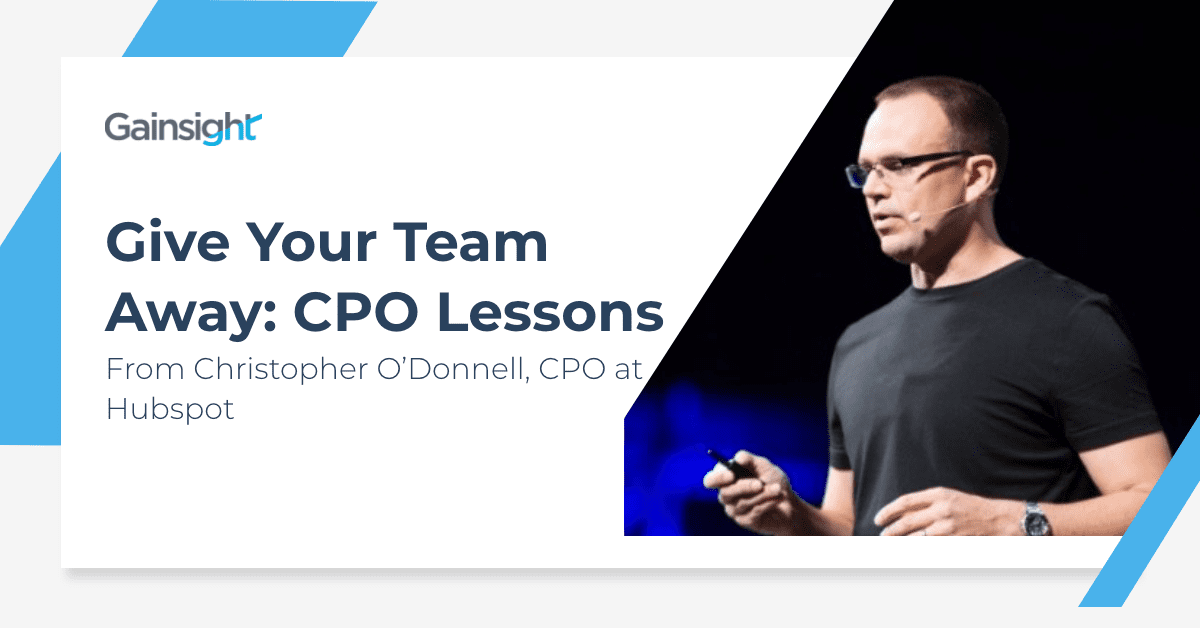In our Path to CPO webinar series, there seems to be a common theme among CPOs. A noticeable trend reveals that product, like customer success, relies on every part of the organization to deliver outcomes. Recently, Nick Mehta, CEO at Gainsight, met with Chris O’Donnell, Chief Product Officer of Hubspot, to get his view on a path into product management.
Hubspot is a growth platform that enables your business teams and organizations, or Hubs, to work collectively. From Marketing to Sales to Services, and even a CRM, the platform connects companies with tools they need to scale effectively. The understanding is that each Hub is powerful alone but better together. Founded in 2006 by Brian Halligan, Chief Executive Officer, and Dharmesh Shah, Chief Technology Officer, Hubspot is headquartered in Cambridge, Massachusetts, with offices and customers worldwide. Their primary focus is on small to medium businesses under 2,000 employees, helping them create jobs, find financial independence, and thus, expand.
Not One Path
Chris shared his path into the C-suite. It did not go unnoticed by Nick that no two journeys for CPOs are the same. Nick found it “interesting to think that each kind of chief product officer is flavored differently.” As Nick shared his viewpoint, Chris connected with his career path.
“Most of the people I have talked to just sort of fall into their work through the bathroom window, I call it. You know, they sort of sneak in,” Chris explained. “There is, I used to say, no way to major in product management.” At Hubspot, they have about one hundred frontline PMs. Of those PMs, none have an undergrad degree in product management. Their crew includes many people who “sort of fell into it” from services, support, sales, and some from marketing.
Like many CPOs, Chris’s story is similar because he began in another field. He studied music and computer science, hoping to have a career in music. Instead, he got a job as a marketer at a small sort of family-owned software company. That was the pivot point for Chris. “I was passionate about the product, and I was able to try a million different jobs. I was a marketer there. I had a ton of fun. Then the two product managers at the company both went back to grad school. They needed somebody who was in the building to work with the engineers and think about product management.” The opportunity presented to Chris was one he refused to waste.
From there, Chris became involved in startups. He had various side projects, dozens of Web apps, and even a laboratory PM leader job. Then, Chris took a chance and joined a startup company called Performable.”I was their first paying customer. But they hired me so I could start resolving my support tickets. It’s a true story!”
A Lesson to be Learned
There is an exciting lesson for everyone to learn that Nick concentrated on. “There’s no one path into a PM position, Nick said. “Some people are trying to get into product management, and I think there’s this perception of imposter syndrome. They may feel like they don’t have the background. I don’t think there is a background for the PM.”
Nick elaborated that he found it compelling that Chris used his knowledge as a product to make it better. Though some may feel like they “fell” into their current position, it is inevitably a space you can grow into. For Chris, his journey was moving every two or more years. But there was also a title change. Though things may look linear from the outside, there is never a straightforward career path and development in product management.
One moment in Chris’s career path was an eye-opener. Around 2012, for 18 months, Chris was working as a Frontline PM. He was working incessantly, grabbing groups that needed a product person because there weren’t many PMs around. By the end of 2013, he was exhausted and depressed.
While out at dinner, his boss at the time conversed with Chris. He told Chris he couldn’t ask him to do anything differently because there was no room for flexibility with the 15 teams that Chris was running. The experience hit him “like a ton of bricks.” The realization for Chris was, “What am I doing?” Chris believed he was going about product management and team building in the wrong way.
Give Your Team Away
Everything changed for Chris after that epiphany. He realized that what was needed was a recruitment strategy. Over time, Chris saw many people come up in their careers. Some take on too much. Others undertake the very harmful practice of kingdom building, which is devastating to any organization. Rather than create silos, he wanted to build a network of people up incoming in their careers. His goal was to mentor, teach, and prepare product managers to move up to the next level in their careers.
“This is what I tell PMs now: your goal is to give your team away.” Chris started an associate product manager or APM program. When he shared that information with Nick, Chris was explicit that the program he created was not a junior product manager job. “It’s a future job,” Chis explained. “The people we bring in are people we think we would want to work for one day.” There is mentorship, stern advice, and redirection to get the people in his programs to the point of leadership. Building people up to let them leave is difficult. Chris describes it as learning to “give your toys away if you want new toys.”
It was in his career path that Chris found the models for mentorship. However, Chris shared that it was peer mentoring that made a significant difference. For him, he explained it with a sense of vulnerability. “Being able to raise your hand to ask a question or find out what an acronym is. That’s an amazing tone to try to understand what’s going on, to teach each other, and share information, before getting into discussion and decision.” Chris also said there is great importance in learning from engineers and designers. Being in a work environment and culture that emphasizes cross-organizational discussion to decide product direction is an incredible bonus.
Nick noted that Chris was a dedicated student of “craft.” Chris responded that anyone who wants to rise to a profession’s heights, especially in product management, had to be coachable and comfortable with ambiguity.
“It’s a hard job where you have a huge amount of responsibility with very little direct authority. It’s a job that crosses many disciplines. It’s a job where you don’t have any idea of how to spend your time. You have to be very comfortable with ambiguity and also very comfortable developing a perspective. You have to be coachable. If you can’t take feedback, that’s the kiss of death.”
Chris explained that he had a hard time early in his career taking feedback and responding to it. He said the lesson he had to share was that the job was difficult. You can make it harder by refusing to learn. “Don’t go into product management because you want to work at a tech company, and you don’t know how to code, and you don’t feel like selling. It’s a game of incomplete information. You’re never going to have all the information you’re going to need. You’re going to have to take risks.”
Your Team is the Product
As a product manager, you are part of a team, but you are also a manager of how the team works. You are not merely producing and selling a product. Chris believes that as an employee, you are selling your company. What you create results from the productivity, the happiness of culture, and the level to which people feel included. So, in effect, there are two products—one for your customers and one product for your employees, which is their culture. To Chris, product management is about psychological safety that PMs and engineers have. From that safety, they impact their own culture and system that provides those same characteristics through the product to customers.
If you understand that you are the product, then you know there are specific levers and information to give and receive. Chris dialed in on feedback “I get a lot of feedback. I talk to my customers. I also get feedback about what it’s like to be on the team.” Chris pays attention to the overall team needs. Significant change and big decisions impact the team and the product. So, besides a psychological need, teams must have physical needs met to improve the product.
“We start with fundamental things. We need to be financially sound. We need our employees to feel happy and safe. We need our customers to succeed. Then you get into growth and strategy.” Through that same lens, PMs can establish a similar product model—usability, reliability, security, and compliance. By analogy, the strategy of team management transfers into product management.
Christopher ultimately believes that you are always trying to improve the product for customers because it represents you. He believes in partnering with engineering managers and the need to lay out a strategic roadmap. He cautioned that automatically doubling PMs will not solve problems. Small teams win. It is a balance between maintenance, innovation, and what the need is. Chris summarized that there is an obligation to listen to both the customer and the team as a PM. Chris has realized that most of all, as a CPO, you have to have passion for the product but especially for the team who creates it. The job is brutal, but the results are worth it.
Learn from more CPOs by watching the whole series here.

